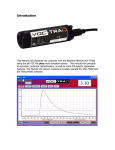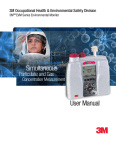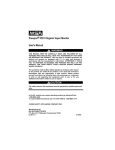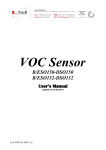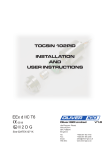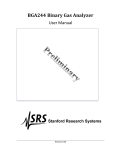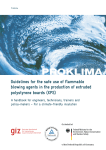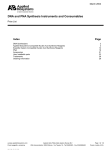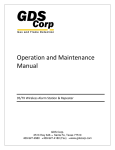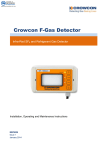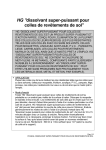Download GDS PID Photoionization Gas Sensor User Manual
Transcript
Operation & Maintenance Manual GDS-PID Photoionization Detector Gas Sensor For Detection of Organic & Inorganic Gases Important: Read and understand contents prior to first use. Improper use or operation could result in instrument malfunction or serious injury. © 2006 Global Detection Systems Corp. All Rights Reserved GDS PID Manual Revision 1.0 July 2006 This page intentionally left blank Global Detection Systems Corp Page 2 [email protected] GDS PID Manual Revision 1.0 July 2006 Table of Contents SECTION 1 – SAFETY INFORMATION 5 1.1 Safety Information – Read Before Installation & Applying Power 5 1.2 Contacting Global Detection Systems Corp. 5 SECTION 2 – PID SPECIFICATIONS 6 SECTION 2 - GENERAL DESCRIPTION 7 3.1 GDS Photoionization (PID) Gas Detector for Organic & Inorganic Gases 7 3.2 Features (Installed in GDS-48 Remote Sensor Housing) 7 3.3 Features (Installed with GASMAX II Gas Monitor) 7 3.4 Photoionization Detection Technology 8 SECTION 4 - OPERATION 9 4.1 Installation and Startup 9 4.2 Warm-up 10 4.3 Normal Operation 10 SECTION 5 - CALIBRATION 12 5.1 Calibration 12 5.2 Calibration with Known Target Gas 12 5.3 Response Factor 12 5.4 Calibration with Isobutylene 13 SECTION 6 – SENSOR MAINTENANCE 15 6.1 15 GDS-PID Maintenance SECTION 7 – PARTS LIST & DRAWINGS 15 APPENDIX 1: IONIZATION POTENTIALS 16 APPENDIX 2: RESPONSE FACTORS 21 Global Detection Systems Corp Page 3 [email protected] GDS PID Manual Revision 1.0 July 2006 This page intentionally left blank Global Detection Systems Corp Page 4 [email protected] GDS PID Manual Revision 1.0 July 2006 SECTION 1 – SAFETY INFORMATION 1.1 Safety Information – Read Before Installation & Applying Power IMPORTANT Users should have a detailed understanding of GDS-PID operating and maintenance instructions. Use the GDS-PID only as specified in this manual or detection of gases and the resulting protection provided may be impaired. Read the following WARNINGS prior to use. WARNINGS • Do not paint the sensor assembly. • Do not use the GDS-PID if its enclosure is damaged or cracked or has missing components. • Make sure the cover and field wiring are securely in place before operation. • Periodically test for correct operation of the system’s alarm events by exposing the monitor / sensor system to a targeted gas concentration above the High Alarm set point. • Do not expose the GDS-PID to electrical shock or continuous severe mechanical shock. • Protect the GDS-PID from dripping liquids and high power sprays. • Use only for applications described within this manual. CAUTION: FOR SAFETY REASONS THIS EQUIPMENT MUST BE OPERATED AND SERVICED BY QUALIFIED PERSONNEL ONLY. READ AND UNDERSTAND INSTRUCTION MANUAL COMPLETELY BEFORE OPERATING OR SERVICING. ATTENTION: POUR DES RAISONS DE SÉCURITÉ, CET ÉQUIPEMENT DOIT ÊTRE UTILISÉ, ENTRETENU ET RÉPARÉ UNIQUEMENT PAR UN PERSONNEL QUALIFIÉ. ÉTUDIER LE MANUE D’INSTRUCTIONS EN ENTIER AVANT D’UTILISER, D’ENTRETENIR OU DE RÉPARER L’ÉQUIPEMENT. 1.2 Contacting Global Detection Systems Corp. To contact Global Detection Systems Corp, please call 409-927-2980, FAX 409-927-4180 or visit us on the web at www.gdscorp.com For sales information, send email to [email protected] or for technical support email us at [email protected] Our headquarters are located at 2513 Hwy 6 in Santa Fe, Texas 77510. Global Detection Systems Corp Page 5 [email protected] GDS PID Manual Revision 1.0 July 2006 SECTION 2 – PID SPECIFICATIONS Model: Available gases: Detection Method: Output (analog): Linear Range: Response Time: Operating Temperature Rating: Operating Voltage: Hazardous Environment Certification Warranty: Global Detection Systems Corp. PID Photoionization Detector for Organic & Inorganic Compounds Volatile Organic Compounds and other gases with an Ionization Potential (IP) of 10.6eV or less (See Appendix A) Diffusion Installed in GDS-48 Universal Sensor Head: Bridge output similar to traditional catalytic bead sensor Installed in GASMAX II Gas Monitor: 4-20 mA (Source type) max. 600 Ohm load at 24 VDC supply voltage Low Range: 0-20 ppm (Isobutylene equivalent) High Range: 0-2000 ppm (Isobutylene equivalent) T90 < 20 Seconds (diffusion mode) Remote installation using GDS-48 Universal Sensor: 0°C to +50°C Local installation with GASMAX II Gas Monitor (Arctic Monitor option): -40°C to +50°C Installed in GDS-48 Universal Sensor Head: 3.3 to 5.0V DC measured at the detector head Installed in GASMAX II Gas Monitor: 10-30 VDC measured at the detector head Installed in GDS-48 Universal Sensor Head: CSA Certified Class 1, Division 1, Groups B, C, D Installed in GASMAX II Gas Monitor: CSA Certified Class 1, Division 1 Groups B, C, D Electronics (GASMAX II) – Two years from date of purchase Sensor: (PID) – One year from date of purchase Global Detection Systems Corp Page 6 [email protected] GDS PID Manual Revision 1.0 July 2006 SECTION 2 - GENERAL DESCRIPTION 3.1 GDS Photoionization (PID) Gas Detector for Organic & Inorganic Gases The GDS-PID photoionization gas detector is a permanently-mounted microprocessor based smart sensor that continuously monitors for a wide range of organic and inorganic gases. With an output similar to a traditional catalytic bead combustible gas sensor, the GDS PID can be connected to a GDS Corp C1 Protector sixteen-channel controller, a GDS Corp C2 Protector two-channel controller, a single or dual channel GASMAX II Gas Monitor, or other instrumentation device that supports a standard Whetstone bridge input that can provide 3.5 - 5VDC excitation voltage. When used locally with the GASMAX II monitor, a standard 4-20mA output, an isolated 4-20mA output, a MODBUS digital output and local alarm relay contacts are available. 3.2 Features (Installed in GDS-48 Remote Sensor Housing) • Output compatible with standard 3-wire catalytic bead bridge-type circuit (3.5 – 5 VDC excitation) • Complete PID sensor, containing detector cell, photoionization lamp, lamp driver, amplifier and filter • 10.6 eV lamp detects common VOCs while remaining insensitive to humidity, O2 or CO2 changes • Replaceable lamp assembly • High range (0 – 2000 ppm) and Low Range (0 – 20 ppm) versions available • Can be installed Intrinsically Safe in hazardous areas (requires IS barrier) – contact factory for details 3.3 Features (Installed with GASMAX II Gas Monitor, C1 Controller or C2 Controller) • All above features plus the following • Smart Sensor records serial number, born-on date and other information (GASMAX only) • Graphic alphanumeric display in engineering units with alarm LEDs • Optional isolated 4-20mA output, MODBUS digital serial output • Optional alarm relay contact closure (3 separate levels + Fault) • Magnetic interface allows setup without declassifying hazardous area • Second GASMAX channel supports simultaneous monitoring of toxic gas using electrochemical sensor Global Detection Systems Corp Page 7 [email protected] GDS PID Manual Revision 1.0 July 2006 3.4 Photoionization Detection Technology The Photoionization Detector (PID) detects a wide variety of organic compounds and some inorganic gases in ambient air. Whether or not a compound can be detected by a PID depends on the lamp energy and the energy required to remove an electron from the target compound molecule (its ionization potential). If the lamp energy is greater than the compounds ionization potential, the PID will detect it. Due to its sensitivity, a PID is not recommended for high concentrations of target gases. However, a PID does not require oxygen to operate and so would be the detector of choice in conditions where O2 levels are unpredictable. A PID can also react to a number of inorganic substances, including Ammonia, Carbon Disulfide, Carbon Tetrachloride, Chloroform, Ethylamine, Formaldehyde and Hydrogen Sulfide. A typical PID block diagram is shown below. Molecules of interest (1) are being exposed to high-energy ultra-violet radiation (2), generated by the gas discharge lamp (3). Some percentage of these molecules are ionized, i.e. converted into positively charged ions and negatively charged electrons: To be ionized, the molecule M should have its Ionization Potential (IP) smaller than the energy of UV lamp photons (E). As a rule, the bigger the difference is between E and IP, the bigger the detector’s response. Both E and IP are usually measured in electron-volts (eV). For the Ionization Potentials of various chemicals, refer to Appendix 2. The pair of electrodes (4, 5) is located in the ionization volume near the lamp window. One of them (polarizing electrode, 4) is connected to the High Voltage DC source (7), the other (signal electrode, 5) is attached to the amplifier (6) input. The electric field, created by these two electrodes, forces both electrons and ions to drift towards their respective electrode, by which they are being collected. The resulting small current is being amplified by the amplifier chip and then the output analog signal is recorded and/or displayed in digital or analog format. The output signal is proportional to the concentration of ionizable molecules in detector’s chamber and thus serves as a measure of concentration. Major air components (N2, O2, CO2) are not ionized by typical lamp’s radiation and therefore do not generate any detector’s response. For this reason, PID is very useful for detection of a wide range of VOCs (Volatile Organic Compounds) in ambient air, down to the low-ppb concentrations, without interference from air components. Global Detection Systems Corp Page 8 [email protected] GDS PID Manual Revision 1.0 July 2006 SECTION 4 - OPERATION 4.1 Installation and Startup Warning: The user shall be made aware that if the equipment is used in a manner not specified by the manufacturer, the protection provided by the equipment may be impaired. The first step in the installation process is to establish a mounting location for the GDS PID. Select a location that is typical of the atmosphere to be monitored or close to the anticipated source of a target gas. It is very important that the GDS PID be properly located to enable it to provide maximum protection. The most effective number and placement of sensors vary depending on the conditions of the application. When determining where to locate sensors the following factors should be considered. • What are the characteristics of the gas that is to be detected? Is it lighter or heavier than air? If it is lighter than air the sensor should be placed above the potential gas leak. Place the sensor close to the floor for gases that are heavier than air or for vapors resulting from flammable liquid spills. Note that air currents can cause a gas that is heavier than air to rise. In addition, if the temperature of the gas is hotter than ambient air or mixed with gases that are lighter than air, it could also rise. • How rapidly will the gas diffuse into the ambient air? Select a location for the sensor that is close to the anticipated source of a gas leak. • Wind or ventilation characteristics of the immediate area must also be considered. Movement of air may cause gas to accumulate more heavily in one area than in another. The detector should be placed in the areas where the most concentrated accumulation of gas is anticipated. For outdoor applications with strong wind conditions, it may require the sensors to be mounted closer together and on the down wind side, to the anticipated area of a gas leak. Also take into consideration for indoor applications, the fact that many ventilation systems do not operate continuously. • The sensor should be accessible for maintenance. • Excessive heat or vibration can cause premature failure of any electronic device and should be avoided if possible. • Follow all national and local installation codes and practices. Both the GDS-48 Universal Sensor housing and GASMAX II Gas Monitor provide a ¾” NPT threaded connector for installation with conduit or shielded cable. Shielded cable is recommended. Wiring should be installed in metal conduit with no other cabling in the same conduit. Global Detection Systems Corp Page 9 [email protected] GDS PID Manual Revision 1.0 July 2006 4.2 Warm-up The GDS PID gas detector is a very sensitive device, and if the sensor has been stored for a significant amount of time, it may become contaminated with trace amounts of ambient detectable compounds. This in turn may cause excessive drift of the background signal during warm-up. Therefore, it is highly recommended to run the sensor for some period of time after prolonged storage, especially if it going to be used for the low level applications. An overnight burn-in period should be sufficient in most cases. During this time, the detector will clean itself and the baseline signal will drop and stabilize. If the sensor is used on a daily basis, it should be allowed to stabilize for 10-20 minutes before use. If high accuracy is not important (for example, in leak detection application) or in the case of measuring relatively high concentrations (> 100 ppm), this stabilization procedure can be skipped. 4.3 Normal Operation The operation of any gas sensor should be checked periodically to ensure proper operation. When first installed, the GDS PID should be challenged with a calibration gas (Isobutylene recommended) to make certain that the detector and any associated alarm systems are functional. Periodically thereafter, the GDS PID should be tested and/or recalibrated as necessary. Normally, initial calibration tests should be done at least monthly, and may be done on a more extended basis once some experience with the sensor and surrounding environment is obtained. The GDS PID responds to a wide range of organic and inorganic molecules. To determine if a particular gas generate a detector response, consult Appendix A and compare the Ionization Potential listed with the GDS PID lamp energy rating (10.6 eV). For example, the GDS PID will detect Ammonia (IP = 10.2), whereas it will not detect Acetylene (IP = 11.41). In general, the lower the IP value, the more sensitive the reading and the lower the Minimum Detectible Quantity (MDQ). Depending on the IP of the compound and some other properties, the sensor’s sensitivity varies significantly from one compound to another. If, for example, the sensor generates double the response to some compound as to Isobutylene, one should expect two times better MDQ, and vice versa – compounds to which the sensor has lesser sensitivity, it will have proportionally higher MDQ. The high range sensor linear range is at least 0 to 2000 ppm of Isobutylene, based on a maximum of 20% non-linearity. The calibration point in this case is 100 ppm. However, the sensor’s signal continues to increase uniformly as concentration increases all the way to 5000 ppm. As a result, the sensor can be used beyond the normal linear range for certain applications, including alarm triggering at high concentrations Global Detection Systems Corp Page 10 [email protected] GDS PID Manual Revision 1.0 July 2006 (4000 ppm, for example). In this case the sensor must be calibrated at this concentration with actual gas samples. Another way to extend the linear range of the GDS PID is to use software linearization. Since the sensor has reproducible characteristics from unit to unit, an appropriate software algorithm can be applied for this purpose. The GASMAX II provides an easy way to enter a specific ten-point piecewise approximation response curve. The overall linearity of the sensor may vary slightly, depending on the target compound. As a rule, if the GDS PID is very sensitive to a given compound, the available linear range will be relatively narrow, and vice versa. Therefore, if some application requires high accuracy, the linearity characteristic of the sensor should be experimentally measured for this particular application’s target compound. A sample’s balance gas affects the sensor’s response to the target gas, mainly as a result of the difference in UV transparency for different balance gases. In a less UV-transparent environment (ex: O2, CH4) the GDS-PID will have a lower response to a target gas than it would in a more UV-transparent environment (ex: N2, H2). Therefore, for best accuracy calibration should be done in an environment that is as close as possible to the actual operating conditions, especially with respect to humidity and the presence of low levels of non-VOC compounds. Global Detection Systems Corp Page 11 [email protected] GDS PID Manual Revision 1.0 July 2006 SECTION 5 - CALIBRATION 5.1 Calibration It is important to understand that the GDS PID is a broadband detector capable of responding to a wide range of organic and inorganic substances, and will respond to any individual gas or combination of gases with IP values less than the lamp UV energy level (10.6 eV). In general, if an actual sample of the expected target compound (between 40% and 80% of the desired full scale value) is available, it is recommended that the GDS PID be calibrated using the target gas in place of Isobutylene. This technique will ensure maximum accuracy. After installation, allow the GDS-PID to stabilize for a period of 8 hours or more, preferably overnight. After stabilization, calibrate the unit as described below. During the first several weeks of operation, periodically calibrate the unit to ensure there are no localized sources of contamination that may block the sensors window. It is recommended that the period between calibrations be no longer than 30 days. 5.2 Calibration with Known Target Gas If a known concentration sample of the desired target gas is available, the GDS PID sensor can be calibrated like any typical sensor. In the case of a GDS PID installed remotely using a GDS-48, the calibration procedure associated with the assigned controller should be used. For example, the C1 Protector sixteen-channel controller provides an option for “Local Calibration” that allows the necessary zero and span adjustments to be performed. See the C1 Protector Controller manual for further details. If the GDS PID is connected to a GASMAX II gas monitor, the standard built-in GASMAX II calibration should be used. See the GASMAX family manual for further details on sensor calibration procedures. IMPORTANT: Calibrating the GDS-PID for a specific gas does not make it selective to that gas. A PID is a wideband detector and will always indicate the total concentration of ionizable VOCs present in the ambient air sample. 5.3 Response Factor In many cases, calibrating the detector with actual target gas is impractical due to toxicity, cost or availability constraints. In these situations, the GDS PID sensor can be calibrated using Isobutylene in place of the target gas and a Response Factor can be applied to the output. The Response Factor is unique for each desired target gas (see Appendix B for a list of GDS-PID Response Factors). Global Detection Systems Corp Page 12 [email protected] GDS PID Manual Revision 1.0 July 2006 The Response Factor measures the ratio between the sensitivity to a standard gas (isobutylene) and that of a target compound. For example, if the GDS PID low range sensor has a typical sensitivity of 1mV/ppm for Isobutylene and 2 mV/ppm for Benzene that means that Benzene Response Factor is equal to ~0.5. The Response Factor is calculated by dividing the actual concentration of a compound introduced into the sensor by the measured detector response: Response Factor = Actual Concentration Measured Response In general, if the Response Factor is less than 1.0, the GDS PID is more sensitive to the target compound that it is to Isobutylene; if greater than 1.0, the GDS PID is less sensitive to the target compound than it is to Isobutylene. 5.4 Calibration with Isobutylene When the desired target gas is unavailable or excessively dangerous, the GDS-PID can be calibrated using isobutylene and the output value adjusted to determine the actual target gas concentration. Manual Conversion: One way to calculate the actual concentration of a target gas is to calibrate the GDSPID using Isobutylene, apply the target gas and manually multiply the detector reading by the target gas Response Factor. This technique is useful if more than one type of gas may be present, or if several different gases may be introduced into the detector, and it is not practical to recalibrate for a specific gas. For example, if a sample of Ammonia (RF = 9.4) in air is applied to a GDS-PID / GASMAX II (Low Range sensor, calibrated for 0-20ppm Isobutylene) monitor and the GASMAX II reads 10ppm, the actual Ammonia concentration would be 94 ppm. 10ppm (Reading) 9.4 (Ammonia RF) = 94 ppm Ammonia Like any photoionization detector, the GDS PID will respond to many different compounds simultaneously. If a single gas is present, a single Response Factor can be used to determine the final reading. In the event that the gas present is a mixture of several compounds, each having a different Response Factor, the process to calculate the actual concentrations is more difficult. In general, Response Factors for various mixtures of gases are not available. However, if the composition of the mixture is known with some accuracy, a corrected Response Factor can be obtained by adding weighted fractions of the different Response Factors of the mixture components. For example, if the mixture contains 60% Benzene and 40% Global Detection Systems Corp Page 13 [email protected] GDS PID Manual Revision 1.0 July 2006 Toluene, multiply the Benzene factor by 0.6, the Toluene factor by 0.4 and add the result to obtain the new factor. Direct readout in PPM: An alternative procedure to calibrate the GDS PID can provide a direct readout on the GASMAX II monitor for a specific compound. NOTE: This procedure does not make the GDS-PID selective to the target compound. RF = Response Factor for specific compound CG = PPM value of isobutylene calibration gas LOW RANGE SENSOR 1. Set the GASMAX II SPAN value [20 * RF] 2. Set the GASMAX II CAL SPAN value to [CG * RF] 3. Make sure no VOCs are present in the ambient air surrounding the GASMAX II. If unable to guarantee no VOCs present, apply a steady flow of 0.5 L/min of ZERO AIR. 4. Perform a ZERO CALIBRATION on the GASMAX II gas monitor. 5. Apply a steady flow of 0.5 L/min of isobutylene calibration gas (8 - 16 ppm recommended) 6. Perform a SPAN CALIBRATION on the GASMAX II gas monitor. 7. The GASMAX II will now display the target gas concentration in PPM. HIGH RANGE SENSOR 8. Set the GASMAX II SPAN value [2000 * RF] 9. Set the GASMAX II CAL SPAN value to [CG * RF] 10. Make sure no VOCs are present in the ambient air surrounding the GASMAX II. If unable to guarantee no VOCs present, apply a steady flow of 0.5 L/min of ZERO AIR. 11. Perform a ZERO CALIBRATION on the GASMAX II gas monitor. 12. Apply a steady flow of 0.5 L/min of isobutylene calibration gas (800 - 1600 ppm recommended) 13. Perform a SPAN CALIBRATION on the GASMAX II gas monitor. 14. The GASMAX II will now display the target gas concentration in PPM. Note: Response factor values are approximate and are only given as a general guide to the response which may be expected from other gases. For accurate readings, it is always better to calibrate the unit with the actual target gas whenever possible. Global Detection Systems Corp Page 14 [email protected] GDS PID Manual Revision 1.0 July 2006 SECTION 6 – SENSOR MAINTENANCE 6.1 GDS-PID Maintenance The GDS-PID sensor is a highly reliable, self-contained photoionization detector that requires very little maintenance other than periodic calibration and lamp replacement. There are no user-serviceable parts. Cleaning – During the course of normal operation, contaminants in the ambient air can cause a reduction in sensitivity due to a build-up of film on the sensor’s UV window. Periodic calibration will compensate for this effect. In the event that the sensor’s sensitivity drops excessively, the sensor should be returned to the factory for cleaning. Lamp Replacement – The sensor’s life span is determined by the life of the UV lamp, typically > 5000 hours of continuous operation. Over the lamp’s lifetime, the output will gradually decline, but the effect will be insignificant until well after 5000 hours of operation. Normal re-calibration will compensate for this effect. The lamp is replaceable. Contact GDS Corp for more information regarding PID sensor refurbishment options. SECTION 7 – PARTS LIST & DRAWINGS Part Number Description 10-9060 10-9061 10-906XR 10-0247 10-0198 10-0205 10-0187 1000-0078 Global Detection Systems Corp Page 15 Photoionization Detector for VOC (0-2000ppm) Photoionization Detector for VOC (0-20ppm) PID Sensor Refurbishment Remote Stainless Steel Sensor Head w/ Cover Sensor splash guard Sensor flow cell for process monitoring Sensor replacement tool Large black magnet for GASMAX II [email protected] Appendix 1: Ionization Potentials Chemical Name A IP (eV) 2-Amino pyridine Acetaldehyde Acetamide Acetic acid Acetic anhydride Acetone Acetonitrile Acetophenone Acetyl bromide Acetyl chloride Acetylene Acrolein Acrylamide Acrylonitrile Allyl alcohol Allyl chloride Ammonia Aniline Anisidine Anisole Arsine B 8 10.21 9.77 10.69 10 9.69 12.2 9.27 10.55 11.02 11.41 10.1 9.5 10.91 9.67 9.9 10.2 7.7 7.44 8.22 9.89 1,3-Butadiene (butadiene) 1-Bromo-2-chloroethane 1-Bromo-2-methylpropane 1-Bromo-4-fluorobenzene 1-Bromobutane 1-Bromopentane 1-Bromopropane 1-Bromopropene 1-Butanethiol 1-Butene 1-Butyne 2,3-Butadione 2-Bromo-2-methylpropane 2-Bromobutane 2-Bromopropane 2-Bromothiophene 2-Butanone (MEK) 3-Bromopropene 3-Butene nitrile Benzaldehyde Benzene 9.07 10.63 10.09 8.99 10.13 10.1 10.18 9.3 9.14 9.58 10.18 9.23 9.89 9.98 10.08 8.63 9.54 9.7 10.39 9.53 9.25 Benzenethiol Benzonitrile Benzotrifluoride Biphenyl Boron oxide Boron trifluoride Bromine Bromobenzene Bromochloromethane Bromoform Butane Butyl mercaptan cis-2-Butene m-Bromotoluene n-Butyl acetate n-Butyl alcohol n-Butyl amine n-Butyl benzene n-Butyl formate n-Butyraldehyde n-Butyric acid n-Butyronitrile o-Bromotoluene p-Bromotoluene p-tert-Butyltoluene s-Butyl amine s-Butyl benzene sec-Butyl acetate t-Butyl amine t-Butyl benzene trans-2-Butene C 8.33 9.71 9.68 8.27 13.5 15.56 10.54 8.98 10.77 10.48 10.63 9.15 9.13 8.81 10.01 10.04 8.71 8.69 10.5 9.86 10.16 11.67 8.79 8.67 8.28 8.7 8.68 9.91 8.64 8.68 9.13 1-Chloro-2-methylpropane 1-Chloro-3-fluorobenzene 1-Chlorobutane 1-Chloropropane 2-Chloro-2-methylpropane 2-Chlorobutane 2-Chloropropane 2-Chlorothiophene 3-Chloropropene Camphor Carbon dioxide Carbon disulfide Carbon monoxide Carbon tetrachloride Chlorine Chlorine dioxide Chlorine trifluoride Chloroacetaldehyde 10.66 9.21 10.67 10.82 10.61 10.65 10.78 8.68 10.04 8.76 13.79 10.07 14.01 11.47 11.48 10.36 12.65 10.61 GDS PID Manual Revision 1.0 July 2006 á -Chloroacetophenone Chlorobenzene Chlorobromomethane Chlorofluoromethane (Freon 22) Chloroform Chlorotrifluoromethane (Freon 13) Chrysene Cresol Crotonaldehyde Cumene (isopropyl benzene) Cyanogen Cyclohexane Cyclohexanol Cyclohexanone Cyclohexene Cyclo-octatetraene Cyclopentadiene Cyclopentane Cyclopentanone Cyclopentene Cyclopropane m-Chlorotoluene o-Chlorotoluene p-Chlorotoluene D 9.44 9.07 10.77 12.45 1,1-Dibromoethane 1,1-Dichloroethane 1,1-Dimethoxyethane 1,1-Dimethylhydrazine 1,2-Dibromoethene 10.19 11.12 9.65 7.28 9.45 12.2 1,2-Dichloro-1,1,2,2tetrafluoroethane (Freon 114) 1,2-Dichloroethane 1,2-Dichloropropane 1,3-Dibromopropane 1,3-Dichloropropane 2,2-Dimethyl butane 2,2-Dimethyl propane 2,3-Dichloropropene 2,3-Dimethyl butane 3,3-Dimethyl butanone cis-Dichloroethene Decaborane Diazomethane Diborane Dibromochloromethane Dibromodifluoromethane Dibromomethane Dibutylamine Global Detection Systems Corp 11.37 12.91 7.59 8.14 9.73 8.75 13.8 9.8 9.75 9.14 8.95 7.99 8.56 10.53 9.26 9.01 10.06 8.83 8.83 8.7 11.12 10.87 10.07 10.85 10.06 10.35 9.82 10.02 9.17 9.65 9.88 9 12 10.59 11.07 10.49 7.69 Page 17 Dichlorodifluoromethane (Freon 12) Dichlorofluoromethane Dichloromethane Diethoxymethane Diethyl amine Diethyl ether Diethyl ketone Diethyl sulfide Diethyl sulfite Difluorodibromomethane Dihydropyran Diiodomethane Diisopropylamine Dimethoxymethane (methylal) Dimethyl amine Dimethyl ether Dimethyl sulfide Dimethylaniline Dimethylformamide Dimethylphthalate Dinitrobenzene Dioxane Diphenyl Dipropyl amine Dipropyl sulfide Durene m-Dichlorobenzene N,N-Diethyl acetamide N,N-Diethyl formamide N,N-Dimethyl acetamide N,N-Dimethyl formamide o-Dichlorobenzene p-Dichlorobenzene p-Dioxane trans-Dichloroethene E Epichlorohydrin Ethane Ethanethiol (ethyl mercaptan) Ethanolamine Ethene Ethyl acetate Ethyl alcohol Ethyl amine Ethyl benzene Ethyl bromide Ethyl chloride (chloroethane) Ethyl disulfide Ethylene Ethyl ether [email protected] 12.31 12.39 11.35 9.7 8.01 9.53 9.32 8.43 9.68 11.07 8.34 9.34 7.73 10 8.24 10 8.69 7.13 9.18 9.64 10.71 9.19 7.95 7.84 8.3 8.03 9.12 8.6 8.89 8.81 9.12 9.06 8.95 9.13 9.66 10.2 11.65 9.29 8.96 10.52 10.11 10.48 8.86 8.76 10.29 10.98 8.27 10.5 9.51 GDS PID Manual Revision 1.0 July 2006 Ethyl formate Ethyl iodide Ethyl isothiocyanate Ethyl mercaptan Ethyl methyl sulfide Ethyl nitrate Ethyl propionate Ethyl thiocyanate Ethylene chlorohydrin Ethylene diamine Ethylene dibromide Ethylene dichloride Ethylene oxide Ethylenelmine Ethynylbenzene F 10.61 9.33 9.14 9.29 8.55 11.22 10 9.89 10.52 8.6 10.37 11.05 10.57 9.2 8.82 2-Furaldehyde Fluorine Fluorobenzene Formaldehyde Formamide Formic acid 9.21 15.7 9.2 10.87 10.25 11.05 11.77 11.3 Freon 11 (trichlorofluoromethane) Freon 112 (1,1,2,2-tetrachloro-1,2difluoroethane) Freon 113 (1,1,2-trichloro-1,2,2trifluororethane) Freon 114 (1,2-dichloro-1,1,2,2tetrafluoroethane) Freon 12 (dichlorodifluoromethane) Freon 13 (chlorotrifluoromethane) Freon 22 (chlorofluoromethane) Furan Furfural m-Fluorotoluene o-Fluorophenol o-Fluorotoluene p-Fluorotoluene H 1-Hexene 2-Heptanone 2-Hexanone Heptane Hexachloroethane Hexane Hydrazine Hydrogen Hydrogen bromide Hydrogen chloride Hydrogen cyanide Hydrogen fluoride Global Detection Systems Corp 11.78 12.2 12.31 12.91 12.45 8.89 9.21 8.92 8.66 8.92 8.79 9.46 9.33 9.35 10.08 11.1 10.18 8.1 15.43 11.62 12.74 13.91 15.77 Page 18 Hydrogen iodide Hydrogen selenide Hydrogen sulfide Hydrogen telluride Hydroquinone I 10.38 9.88 10.46 9.14 7.95 1-Iodo-2-methylpropane 1-Iodobutane 1-Iodopentane 1-Iodopropane 2-Iodobutane 2-Iodopropane Iodine Iodobenzene Isobutane (Isobutylene) Isobutyl acetate Isobutyl alcohol Isobutyl amine Isobutyl formate Isobutyraldehyde Isobutyric acid Isopentane Isophorone Isoprene Isopropyl acetate Isopropyl alcohol Isopropyl amine Isopropyl benzene Isopropyl ether Isovaleraldehyde m-Iodotoluene o-Iodotoluene p-Iodotoluene K 9.18 9.21 9.19 9.26 9.09 9.17 9.28 8.73 9.4 9.97 10.12 8.7 10.46 9.74 10.02 10.32 9.07 8.85 9.99 10.16 8.72 8.69 9.2 9.71 8.61 8.62 8.5 Ketene L 9.61 2,3-Lutidine 2,4-Lutidine 2,6-Lutidine M 8.85 8.85 8.85 2-Methyl furan 2-Methyl naphthalene 1-Methyl naphthalene 2-Methyl propene 2-Methyl-1-butene 2-Methylpentane 3-Methyl-1-butene 3-Methyl-2-butene 3-Methylpentane [email protected] 8.39 7.96 7.96 9.23 9.12 10.12 9.51 8.67 10.08 GDS PID Manual Revision 1.0 July 2006 4-Methylcyclohexene Maleic anhydride Mesityl oxide Mesitylene Methane Methanethiol (methyl mercaptan) Methyl acetate Methyl acetylene Methyl acrylate Methyl alcohol Methyl amine Methyl bromide Methyl butyl ketone Methyl butyrate Methyl cellosolve Methyl chloride Methyl chloroform (1,1,1trichloroethane) Methyl disulfide Methyl ethyl ketone Methyl formate Methyl iodide Methyl isobutyl ketone Methyl isobutyrate Methyl isocyanate Methyl isopropyl ketone Methyl isothiocyanate Methyl mercaptan Methyl methacrylate Methyl propionate Methyl propyl ketone á -Methyl styrene Methyl thiocyanate Methylal (dimethoxymethane) Methylcyclohexane Methylene chloride Methyl-n-amyl ketone Monomethyl aniline Monomethyl hydrazine Morpholine n-Methyl acetamide N 1-Nitropropane 2-Nitropropane Naphthalene Nickel carbonyl Nitric oxide, (NO) Nitrobenzene Nitroethane Nitrogen Global Detection Systems Corp 8.91 10.8 9.08 8.4 12.98 9.44 10.27 10.37 9.9 10.85 8.97 10.54 9.34 10.07 9.6 11.28 11 8.46 9.53 10.82 9.54 9.3 9.98 10.67 9.32 9.25 9.44 9.7 10.15 9.39 8.35 10.07 10 9.85 11.32 9.3 7.32 7.67 8.2 8.9 10.88 10.71 8.12 8.27 9.25 9.92 10.88 15.58 Page 19 Nitrogen dioxide Nitrogen trifluoride Nitromethane Nitrotoluene p-Nitrochloro benzene O 9.78 12.97 11.08 9.45 9.96 Octane Oxygen Ozone P 9.82 12.08 12.08 1-Pentene 1-Propanethiol 2,4-Pentanedione 2-Pentanone 2-Picoline 3-Picoline 4-Picoline n-Propyl nitrate Pentaborane Pentane Perchloroethylene Pheneloic Phenol Phenyl ether (diphenyl oxide) Phenyl hydrazine Phenyl isocyanate Phenyl isothiocyanate Phenylene diamine Phosgene Phosphine Phosphorus trichloride Phthalic anhydride Propane Propargyl alcohol Propiolactone Propionaldehyde Propionic acid Propionitrile Propyl acetate Propyl alcohol Propyl amine Propyl benzene Propyl ether Propyl formate Propylene Propylene dichloride Propylene imine Propylene oxide Propyne 9.5 9.2 8.87 9.38 9.02 9.02 9.04 11.07 10.4 10.35 9.32 8.18 8.5 8.82 7.64 8.77 8.52 6.89 11.77 9.87 9.91 10 11.07 10.51 9.7 9.98 10.24 11.84 10.04 10.2 8.78 8.72 9.27 10.54 9.73 10.87 9 10.22 10.36 [email protected] GDS PID Manual Revision 1.0 July 2006 Pyridine Pyrrole Q 9.32 8.2 Quinone S 10.04 Stibine Styrene Sulfur dioxide Sulfur hexafluoride Sulfur monochloride Sulfuryl fluoride T 9.51 8.47 12.3 15.33 9.66 13 o-Terphenyls 1,1,2,2-Tetrachloro-1,2difluoroethane (Freon 112) 1,1,1-Trichloroethane 1,1,2-Trichloro-1,2,2-trifluoroethane (Freon 113) 2,2,4-Trimethyl pentane o-Toluidine Tetrachloroethane Tetrachloroethene Tetrachloromethane Tetrahydrofuran Tetrahydropyran Thiolacetic acid Thiophene Toluene Tribromoethene Tribromofluoromethane Tribromomethane Trichloroethene Trichloroethylene Trichlorofluoromethane (Freon 11) Trichloromethane Triethylamine Trifluoromonobromo-methane Trimethyl amine Tripropyl amine V o-Vinyl toluene Valeraldehyde Valeric acid Vinyl acetate Vinyl bromide Vinyl chloride Vinyl methyl ether W Water 1 X Global Detection Systems Corp 2,4-Xylidine m-Xylene o-Xylene p-Xylene 7.65 8.56 8.56 8.45 7.78 11.3 11 11.78 9.86 7.44 11.62 9.32 11.47 9.54 9.25 10 8.86 8.82 9.27 10.67 10.51 9.45 9.47 11.77 11.42 7.5 11.4 7.82 7.23 8.2 9.82 10.12 9.19 9.8 10 8.93 2.59 Page 20 [email protected] Appendix 2: Response Factors Chemical Name 1,2,3-trimethylbenzene 1,2,4-trimethylbenzene 1,2-dibromoethane 1,2-dichlorobenzene 1,2-dichloroethane (11.7 lamp) 1,3,5-trimethylbenzene 1,4-dioxane 1-butanol 1-methoxy-2-propanol 1-propanol 2-butoxyethanol 2-methoxyethanol 2-pentanone 2-picoline 3-picoline 4-hydroxy-4-methyl-2-pentanone acetaldehyde acetic acid acetone acetophenone acrolein allyl alcohol ammonia amylacetate arsine benzene bromoform bromomethane butadiene butyl acetate carbon disulfide chlorobenzene cumene (isopropylbenzene) cyclohexane cyclohexanone decane diethylamine dimethoxymethane dimethyl disulfide diesel fuel #1 diesel fuel #2 epichlorhydrin RF 0.49 0.43 11.70 0.50 0.50 0.34 1.40 3.40 1.40 5.70 1.30 2.50 0.78 0.57 0.90 0.55 10.80 11.00 1.20 0.59 3.90 2.50 9.40 3.50 2.60 0.53 2.30 1.80 0.69 2.40 1.20 0.40 0.54 1.50 0.82 1.60 1.00 11.30 0.30 0.90 0.75 7.60 ethanol ethyl acetate ethyl acetoacetate ethyl acrylate ethyl ether (diethyl ether) ethyl mercaptan ethylbenzene ethylene ethylene glycol ethylene oxide gasoline heptane hydrazine hydrogen sulfide isoamyl acetate isobutanol isobutyl acetate isobutylene isooctane isopentane isophorone isoprene (2-methyl-1,3-butadiene) isopropanol isopropyl acetate isopropyl ether isopropylamine Jet A fuel JP-5 fuel JP-8 fuel mesityl oxide methanol (11.7 lamp) methyl acetate methyl acetoacetate methyl acrylate methyl benzoate methyl ethyl ketone methyl isobutyl ketone methyl mercaptan methyl methacrylate methyl tert-butyl ether methylamine methylbenzil alcohol methylene chloride (11.7 lamp) m-xylene naphtalene 10.00 4.20 0.90 2.30 1.20 0.60 0.51 10.10 15.70 19.50 1.10 2.50 2.60 3.20 1.80 4.70 2.60 1.00 1.30 8.00 0.74 0.60 5.60 2.60 0.80 0.90 0.40 0.48 0.48 0.47 2.50 7.00 1.10 3.40 0.93 0.90 1.10 0.60 1.50 0.86 1.20 0.80 0.85 0.53 0.37 GDS PID Manual Revision 1.0 July 2006 n,n-dimethylacetamide n,n-dimethylformamide n-hexane nitric oxide n-nonane nitrogen dioxide (11.7 lamp) n-pentane n-propyl acetate octane o-xylene phenol phosphine pinene, alpha pinene, beta propionaldehyde (propanal) propylene propylene oxide p-xylene pyridine quinoline styrene tert-butyl alcohol tert-butyl mercaptan tert-butylamine tetrachloroethylene tetrahydrofuran thiophene toluene trans-1,2-Dichloroethene trichloroethylene trimethylamine turpentine - crude sulfite turpentine - pure gum vinyl acetate vinyl bromide vinyl chloride vinylcyclohexane (VCH) vinylidene chloride (1,1-DCE) 0.73 0.80 4.50 7.20 1.60 10.00 9.70 3.10 2.20 0.54 1.00 2.80 0.40 0.40 14.80 1.30 6.50 0.50 0.79 0.72 0.40 3.40 0.55 0.71 0.56 1.60 0.47 0.53 0.45 0.50 0.83 1.00 0.45 1.30 0.40 1.80 0.54 0.80 Note: Data extracted from industry literature; actual data has not been independently validated by GDS Corp. Response factor values are approximate and are only given as a general guide to the response which may be expected from other gases. For accurate readings, it is always better to calibrate the unit with the actual target gas whenever possible. Global Detection Systems Corp Page 22 [email protected]






















